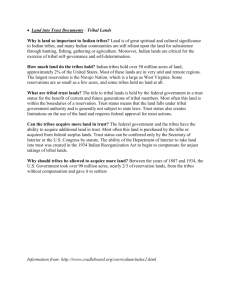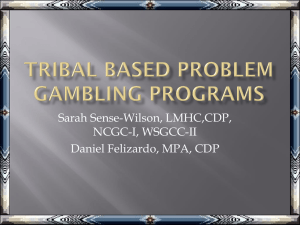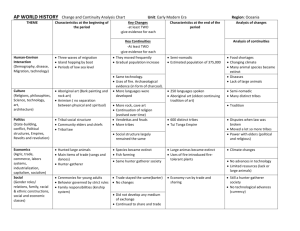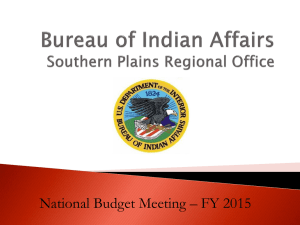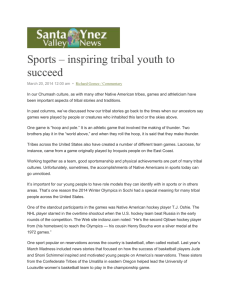Yankton Sioux Tribe
advertisement
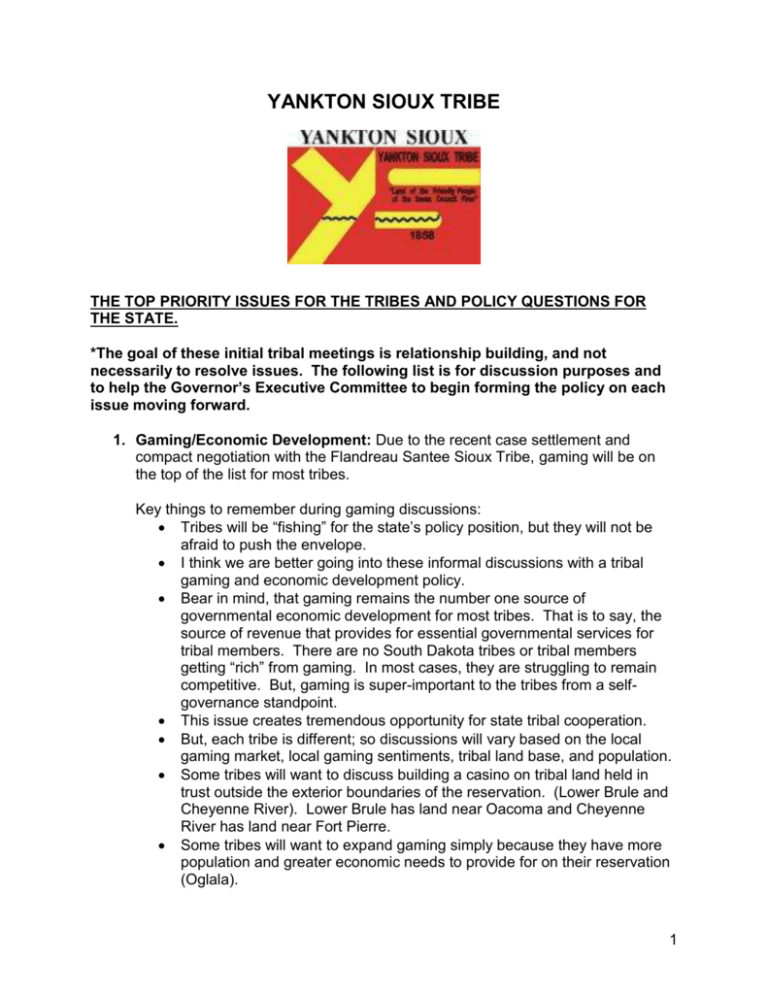
YANKTON SIOUX TRIBE
THE TOP PRIORITY ISSUES FOR THE TRIBES AND POLICY QUESTIONS FOR
THE STATE.
*The goal of these initial tribal meetings is relationship building, and not
necessarily to resolve issues. The following list is for discussion purposes and
to help the Governor’s Executive Committee to begin forming the policy on each
issue moving forward.
1. Gaming/Economic Development: Due to the recent case settlement and
compact negotiation with the Flandreau Santee Sioux Tribe, gaming will be on
the top of the list for most tribes.
Key things to remember during gaming discussions:
Tribes will be “fishing” for the state’s policy position, but they will not be
afraid to push the envelope.
I think we are better going into these informal discussions with a tribal
gaming and economic development policy.
Bear in mind, that gaming remains the number one source of
governmental economic development for most tribes. That is to say, the
source of revenue that provides for essential governmental services for
tribal members. There are no South Dakota tribes or tribal members
getting “rich” from gaming. In most cases, they are struggling to remain
competitive. But, gaming is super-important to the tribes from a selfgovernance standpoint.
This issue creates tremendous opportunity for state tribal cooperation.
But, each tribe is different; so discussions will vary based on the local
gaming market, local gaming sentiments, tribal land base, and population.
Some tribes will want to discuss building a casino on tribal land held in
trust outside the exterior boundaries of the reservation. (Lower Brule and
Cheyenne River). Lower Brule has land near Oacoma and Cheyenne
River has land near Fort Pierre.
Some tribes will want to expand gaming simply because they have more
population and greater economic needs to provide for on their reservation
(Oglala).
1
Some tribes will want to expand because they have made recent
improvements to their casinos or have planned improvements, and need
additional games to pay debt service on expansion loans. (Yankton,
Rosebud, and Crow Creek)
Some tribes will want to expand because they have a good track record of
gaming in North Dakota and think that their expertise will translate to
success in South Dakota. (Standing Rock and Sisseton Wahpeton).
While other tribes will want to enter into gaming for the first time.
(Cheyenne River)
Tribes will also discuss other economic development ideas, such as wind
energy development, oil and gas drilling, grocery marketing, agriculture,
information technology, small business development, and tourism, but
they will likely want to discuss gaming first and foremost.
2. Land In Trust Applications: A major source of contention between tribes and
state and local government, this has been an impediment to improving state tribal
relations. Attorney General, Marty Jackley has stated in a meeting with me that
his policy is to oppose only off-reservation land in trust applications. While the
Bureau of Indian Affairs has stated that it does not think the State should oppose
any application regardless of type or purpose. Tribes see this as a right of self
governance and have prevailed on a majority of contested cases. The
Department of Tribal Relations is studying the issue and will provide a report to
the Governor on July 20th.
Key points to remember when discussing this issue:
Tribes see this issue as a sovereign right. After the Sioux tribes lost
millions of acres of land during the General Allotment Act, Congress
passed the Indian Reorganization Act to reverse the ill effects of the
allotment era. In addition to reorganizing tribal government, the act
provided for means of economic development, including the ability for
tribes to re-acquire lands through the land in trust process. This process
is relatively simple, but it has been complicated by the competing interests
of tribal and local and state governments.
One of the first controversial cases was the Lower Brule Oacoma case in
the 1990’s. The tribe requested land to be transferred to trust status for
purposes of economic development, meaning the land would not be
subject to local taxes and any income derived from that land while in trust
status would also be tax free. The case was opposed by the South Dakota
Attorney General’s office. The case was decided in federal court in favor
of the tribe and the controversy over land in trust applications has
persisted since.
Counties are concerned about lost tax revenue, tribal jurisdiction over nonIndians, and tribal regulatory authority over non-Indians.
The AG’s office has stood in support of local government interests and
does not trust the land in trust process.
2
This is a policy driven issue and like gaming, we are better off going into
the tribal meetings with a good idea of where we want to be policy wise
moving forward.
Solutions include the creation of a Payment in Lieu of Taxes fund through
the Bureau of Indian Affairs to offset the tax issue, but that does not do
anything to assuage concerns over tribal jurisdiction and regulatory
authority over non-Indians.
The resolution of this issue could lead to improved state tribal cooperative
efforts on law enforcement and public safety.
If we are going to move forward and improve tribal relations, substantial
progress must be made on this issue.
3. Taxation:
8 of 9 tribes in South Dakota have state tribal tax collection
agreements, but some tribes want to re-negotiate the terms of their
agreements.
Tribes will want to renegotiate revenue percentages based on changes in
their population.
Another question pertains to the South Dakota wind energy tax. Tribes
cannot afford to develop wind energy on their own, so they partner with
developers who, in turn, are discouraged from investing due to the state
wind energy tax.
Tribes are seeking an exemption. Legislation was proposed in the last
session, but it did not make it out of committee.
This is another policy question moving forward. I propose a task force to
study the issue further; mainly to study the economic impact of granting
tribal exemptions or entering into cooperative agreements.
Wind could be a major source of economic development for tribes, but not
under the current tax structure.
Possible solutions include, exemptions, revenue sharing agreements,
shared regulatory authority.
4. Tribal Consultation: During my tribal visits, tribal officials have consistently
expressed concern over the lack of consultation with the tribes.
SDCL 1-54-5 requires consultation with tribal governments, but it is not
defined or uniform throughout state government.
I think an executive order requiring all state programs to consult with tribes
on a government to government basis, would go a long way in improving
state tribal relations and increasing communication.
But, the state tribal consultation process must be created and defined.
Some tribes straddle the North and South Dakota borders (Standing Rock
and Sisseton) and therefore have to work closely with both states. This
creates more bureaucracy for the tribes.
It may be appropriate to create a unique consultation process with those
tribes to include collaboration with North Dakota or even create a
reciprocity policy on some state tribal issues.
3
5. Healthcare: Tribes and tribal members are frustrated over the lack of adequate
health care services on the reservation and the lack of portability of their health
care benefits through the Indian Health Service. Particularly when they receive
health care from a non-Indian health care facility and their bill goes unpaid by
HIS. To add to their frustrations, their individual credit is ruined when their bill
goes to a collection agency because they truly cannot afford to pay for their
hospital bill and their request to have HIS pay is tied up in red tape.
Tribes see this as a violation of US treaty obligations.
The tribes want to draw attention to this issue and are seeking state
support.
This is a ready-made issue for state tribal cooperation.
Solutions include joint meetings with congressional delegates to seek full
funding of Indian Health Service; increased services that can be fully
reimbursed by Medicaid, which would require changes to the state
Medicaid plan, so tribes can afford doctors, dentists, and specialists.
Healthcare is in a crisis on the reservations, especially the affordability of
certain types of care such as dialysis, mental health services, and
emergency care.
6. Social Services: Tribes will want to discuss many issues with the Governor
pertaining to the Department of Social Services including the following:
Indian Child Welfare Act (ICWA): Tribes are very concerned about the
state’s compliance with the Indian Child Welfare Act. A study was
conducted in 2004 which produced findings and recommendations to the
State DSS and other state entities to increase compliance.
Many tribal constituents look to state ICWA compliance as a gauge of
state tribal relations. They feel that if the state is willing to assess its
system of care to enforce compliance with the ICWA, then we are indeed
moving forward in improved governmental relations.
Representative Stricherz, a member of the state tribal relations committee,
broached this subject during the recent committee meeting, has
requested a meeting with the Department of Tribal Relations, and is
seeking a subsequent meeting with DSS.
But, I would like to see us beat her to the punch on this issue, by
garnering greater bi-partisan support and by creating policy on ICWA
compliance.
Like the AG’s opposition to land in trust applications, ICWA compliance (or
the perceived lack of it) remains one of the major impediments to
improved state tribal relations.
Indian Foster Homes: Pertaining to ICWA both directly and indirectly is
the issue of Indian foster care homes or the lack of them. Tribes believe
this is due to overly stringent foster care licensing standards. Legislative
efforts have been made with no results. Tribes would like to see different
standards for Indian families.
4
Solutions to both the ICWA and Foster Care issues, is to consider draft
legislation similar to the Minnesota Indian Family Preservation Act. This
legislation makes it certain, that compliance with the ICWA remains a
state priority by obligating the state to take clear steps to ensure
compliance. It also provides for family support services such as the
recruitment and training of Indian foster homes, special advocates for
Indian children and families, special services to ensure active efforts
toward family reunification, parenting classes, and family rehabilitative
services, special training for social workers, and court monitoring
services.
Low Income Energy Assistance Program: this is a federal program that
some tribes run themselves. It provides financial assistance to tribal
members for heating and cooling needs. It is a controversial program as
people without the most basic of needs fight for these resources. But it is
essential.
The issue for tribes is they don’t feel they are getting a fair share of the
federal allocation that comes through the state. Tribes will sometimes
refer to these federal resources as “pass through dollars” or money
intended for the tribes, but can only be accessed through the state.
DSS and Tribal Relations has scheduled individual meetings with
Cheyenne River and Oglala, both of whom run their own programs. We
are meeting to explain their current agreements and the allocation
formula. We will follow up with a meeting with all the tribes (a
consultation process of sorts) to discuss the LIEAP allocation formula.
7. Education: Most tribes have a diverse school system consisting of schools
funded by the Bureau of Education, Department of Interior; state public schools;
and tribal schools. Most tribes will have a local tribal community college. Tribes
will want to discuss the following:
Lack of cultural sensitivity for Native American Indian students in state
public schools, despite large infusion of Impact Aid dollars due to high
Native American enrollment.
Lack of culturally relevant curriculum in public school curriculum.
High drop-out rates
Need for new school construction
Lakota, Dakota, Nakota Language preservation
8. Transportation/Infrastructure Development: The larger tribes will want to
discuss the need for roads and other infrastructure development.
Road construction/improvement
Utilities (electricity, communications)
Water resources
Public housing
9. State Tribal Fiscal Relations: “Federal Pass Through Dollars”: Most tribes
will express a concern about federal dollars that are passed onto the tribes
5
through state government and the need for them to get a larger share of those
federal allocations. Similar to the discussion about LIEAP here are some other
examples:
Department of Health and Human Services money for mental health,
substance abuse and social services.
Title IV E
Transportation
Department of Energy (LIEAP)
Homeland Security and Veterans Services
ISSUES SPECIFIC TO THE YANKTON SIOUX TRIBE:
Boundary Recognition: Tribe wants the Yankton Sioux Reservation recognized
on South Dakota state maps
Land in Trust
Gaming Compact
Health Care
Taxation
Education
DEMOGRAPHICS AND BACKGROUND INFORMATION:
Population*:
2878
Total: 6465 One Race: 6250
White alone: 3325 AI/AN alone:
Two or more races: 215
*2010 Census numbers
Reservation: Diminished Yankton Reservation; part of Charles Mix County
Division: Yankton
Bands: Ihanktonwan (ee-honk-toe-wan)
Land Area: Approximately 40,000 acres (without boundaries)
Tribal Headquarters: Marty, SD
Time Zone: Central
Traditional Language: Dakota
Enrolled members living within diminished area: 3,500
Major Employers: Fort Randall Casino, Indian Health Service, tribal office, Bureau of
Indian Affairs, Marty Indian School
Government
Charter: None; Constitution and Bylaws: Yes - non-IRA
Date Approved: April 24, 1963
Name of Governing Body: Yankton Sioux Tribal Business and Claims Committee
Number of committee members: (5) five committee members
Dates of Constitutional amendments: March 20, 1975
Number of Executive Officers: (4) Chairman, Vice-Chairman, Secretary, Treasurer
Elections
Primary election is in July and the General is every two years on the first Thursday in
6
September. Executive officers are elected at large and serve two year terms in office.
Number of Election districts or communities: 5
Meetings:
Regular business meeting are held once a week usually on Tuesday. An annual
General Council Meeting is set for the third Tuesday in August each year.
Quorum number: 5 members
U.S. Census Bureau (2000)*
Labor Force: 2,602
Employed: 2,283
Unemployed: 317
Unemployment Rate: 12.2%
*Statistics represent labor characteristics of the reservation, not the tribe.
FACTS AND HISTORY:
Known as the Ihanktowan Dakota Oyate (Dwellers of the End Village), the Yankton
Sioux Tribe’s land is located in southeast South Dakota in Charles Mix County along the
Missouri River bottom bordering the state of Nebraska. The area of the reservation is
approximately 262,300 acres. It is the second largest Indian reservation in the U.S. that
is located entirely within one county.
The reservation is the homeland of the Ihanktowan (Yankton) and the Ihanktowanna
(Yanktonai) who refer to themselves as Nakota.
In the 16th and early 17th centuries, the Yankton and Yanktonai were one tribe. The 18 th
century saw the Yankton range north and west into Minnesota and South Dakota.
During this time, the Yanktonai followed the Teton tribes west. By the early 19 th century,
the Yanktonai hunted buffalo between the Red and Missouri Rivers.
In 1804, the friendly Yankton engaged Lewis and Clark in two ceremonies of smoking
from the “pipe of peace” and in a party with music and dance. Clark described the
Yanktons as “stout, bold looking people.”
The Yanktons ceded 2.2 million acres of land to Iowa between 1830 and 1837. In 1858,
the tribe ceded another 11 million acres. By 1860, the tribe had turned over almost all of
its remaining land to the U.S. government, and most Yanktons moved to the Yankton
Reservation in South Dakota. When established, the reservation had 435,000 acres;
but, starting in 1887, homesteading by non-Indian settlers withdrew much of the
reservation from tribal control. In 1932, the Yankton created their first Tribal
Constitution. They became a recognized tribe of the Indian Reorganization Act of 1934.
Folklore has it that while Lewis and Clark convened with the Yanktons in 1804 on
Calumet Bluff, a male child was born. Learning of this fact, Captain Lewis sent for the
child and wrapped him in an American flag. Lewis proceeded with a speech in which he
prophesied that the boy would live to become eminent among his people and would be
a great friend of the white men. Struck By The Ree grew up to become Chief of the
7
Yankton Tribe. As a leader, he befriended the whites, yet remained dedicated and loyal
to his people. He died in 1888 in Greenwood, SD.
PAST LEADERS:
Chief Struck By The Ree, (1804-1888) a Yankton chief, was wrapped in an
American flag by Meriwether Lewis. Lewis and Clark were in the area exploring
Louisiana Purchase lands. As a leader, Struck By The Ree managed to befriend the
whites, yet remain dedicated and loyal to his people. He died in 1888 at Greenwood.
Chief Smutty Bear, Mato Sabi Ceya (1790? - 1865) which has been said to mean
He Paints Himself Dark Like A Bear, a Ihanktonwan Chief, was a signer of four
treaties. He signed the Treaty of 1825, the Fourth Treaty of Prairie Du Chien of 1830
Treaty with the Sauk and Foxes, etc., 1830., the Fort Laramie Treaty of 1851, and
the Treaty of 1858. He was a strong defender and believer in tribal sovereignty.
Spellings of Chief Smutty Bear's name, following the chronological order of the
treaties, are as follows : Maw-too-an-be-kin, Matto-sa-becha, Mak-toe-sah-bi-chis
and Ma-to-sa-be-che-a.
PRESENT LEADERS:
Chairman: Bobby Cournoyer
Vice-Chairman: Karen Archambeau
Secretary: Rachel Bernie
Treasurer: Leo O’Connor
Tribal Council Members:
Baptiste Cournoyer
Dennis Rooker
Greg Zephier
Jody Zephier
Myron Turner
NOTED TRIBAL MEMBERS:
Brian Drapeaux – former Daschle staffer & currently Chief of Staff, BIE
Indigenous - is an American blues-rock group that came to prominence in the late
1990s. The band originally consisted of two brothers, Mato Nanji (Maiari) ('mah-TOE
non-GEE' vocals and guitar, born 1974), Pte ('peh-TAY' bass guitar), along with their
sister, Wanbdi ('wan-ba-DEE' drums, vocals), and their cousin, Horse (percussion).
After the 2006 release of Chasing the Sun, Mato Nanji was the only family member
left in Indigenous. Currently, Indigenous only has one original member (Mato) and
he has hired new people.
Things We Do (Pachyderm Records, 1998)
Native American Music Award for Album of the Year, Group of the Year, and
Best Pop Group
Blues This Morning EP (Pachyderm, 1999)
Live at Pachyderm Studios (Pachyderm, 1999)
8
Native American Music Award for Blues Album of the Year, Group of the Year
Circle (Pachyderm, 2000)
#3 Billboard Top Blues Albums
Indigenous (Zomba/Silvertone, 2003)
#3 Billboard Top Blues Albums
Long Way Home EP (Indigenous Records, 2005)
Chasing the Sun (Vanguard, 2006)
#2 Billboard Top Blues Albums
Broken Lands (Vanguard, 2008)
The Acoustic Sessions (2010)
SENSITIVITY ISSUES:
Do not refer to the tribes as “our tribes”, “South Dakota tribes”, etc or any other
term(s) that sound paternalistic.
Do not refer to tribal citizens as “your people”, “the Indian people”, etc. It is more
proper to refer generally to “the people” or “tribal members” or “tribal citizens”.
When people speak, it may not sound as they are on the current topic. Let them
finish – it will have a point.
Sovereignty and treaties are important to the tribes.
Shake everyone’s hand when greeting and when departing.
Prayers are usually said before a meeting. Since these tribal visits are over a
meal, a prayer offering will be made before a meal.
Address tribal head appropriately – Chairman or President – as a sign of respect
for their office, at least for starters.
Humor may be interspersed through out conversation (serious and common
dialogue) – do not be offended – it is a sign people are comfortable around you.
Eye contact may or may not be made during conversation. Do not be offended, it
is not a sign of disrespect.
Do not assume tribal officials understand how state government works.
“When in Rome….”
Be Yourself!
9




